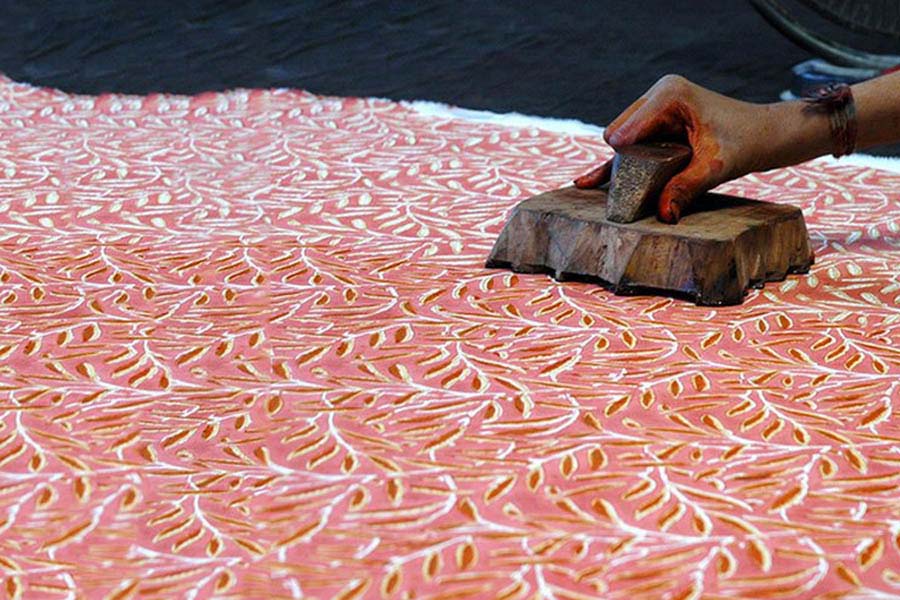Know your prints
A mosaic of colours, patterns and designs that seem to flow seamlessly and co-exist peacefully. Yet nothing about it is predictable, passive or typical. Exclusive, vibrant and diverse. That’s Indian textiles for you—a rich tapestry of distinct prints in myriad hues and nature-inspired themes.
Our country is home to several textile printing styles, each representing the cultural nuances of the region it is from. Let us look at the origin of some of the major textile prints in India, what makes them so magical, and their relevance today.
Kalamkari
This is a very ancient Indian art form, said to be about 3,000 years old. There are two main styles of kalamkari art done in Andhra Pradesh: Srikalahasti style (hand painting using a pen) and Machilipatnam style (block printing). Tamilnadu too has a form of Kalamkari, done in Sickinaikenpet (in Thanjavur district). It is done using a stick wound with thread dipped in dye.
The artists use natural dyes (from cow dung, seeds, plants and crushed flowers), which give the fabric an earthy charm. The chief colours used in kalamkari are red, yellow, blue and black to represent motifs such as animals, birds, flowers and paisleys, deities and scenes from Hindu epics and mythological stories.
Bagru
This is a centuries-old indigenous all-natural technique of hand-block printing done using natural colours by the Chippas community in Bagru, once a sleepy village on the Jaipur-Ajmer road in Rajasthan. In this style, motifs are transferred onto a coloured background with wooden blocks using direct or resist (hiding the print from the dye) style.
No printing technique is as eco-friendly as Bagru—the base cloth is treated with multani mitti and soaked in turmeric, natural agents such as alum, pomegranate rinds, dry flowers, turmeric, indigo and madder root are used to dye the fabric.
Bagru printing is usually done on a blue/indigo background. The Bagru prints are large with bold lines. The motifs used are simple and elegant, geometric patterns and nature-inspired designs like flowers, birds, tendril and trellises.
Sanganer
This printing technique flourished between the 16th and 17th century. It is said that constant clashes with the Mughals and Marathas led several craftsmen to migrate from Gujarat to Rajasthan. The craft form finally found firm footing in Sanganer, a small town in the Dhundhar region of Rajasthan. Known for its original designs, it was one of the primary items of export for the East India Company.
Sanganer block printing is done over off-white or white background using wooden blocks or screen printers. It is known for its intricate floral patterns with fine detailing. Roses, rosettes, sunflowers, lotuses, lilies and marigolds are the commonly used motifs.
Bagh
This form of textile printing is done in Bagh, Madhya Pradesh. The printing form can be traced to the community of Muslim Khatris who ventured from Larkana in Sind to Marwadi Thar and Manawar in Madhya Pradesh, before settling down in Bagh.
In this elaborate technique, the cloth (silk or cotton) is treated with a blend of corroded iron filings, alum and alizarin. Once the printing is done, the fabric is washed repeatedly in the river and sun-dried to get the desired lustre. The traditional motifs of Bagh include the Nandana mango, the tendu plant, mung ki phali, leheria, and phool buta motifs.
Ajrak
The Ajrak tradition can be traced back to the Indus Valley Civilisation (2500 BC-1500 BC). The word ‘ajrak’ comes from the Arabic kaword ‘azrak’, meaning blue, which is the main colour in this style of printing. The craft form is a Sindhi tradition practised by the Khatri community on the banks of the river Sindh. These families migrated to Kutch in the 16th century.
Ajrak printing is a time-consuming process in which the fabric is printed with a resist paste and dyed. It is repeated several times with different dyes to get the desired deep crimson red and indigo blue tones in symmetrical web-like jaal and other patterns. The whole process can take up to two weeks!
Modern uses
Though they are several centuries old, these traditional printed fabrics have found relevance in the modern age. For instance, kalamkari is now done on silk and cotton fabrics for a range of products such as sarees, salwar kurtas, wall décor, home furnishing, bags and purses. While Sanganer, Bagh and Bagru prints have made their way into scarves, stoles, skirts and dresses. Bedsheets, lampshades, curtains and upholstery are the other applications of these printed fabrics.

